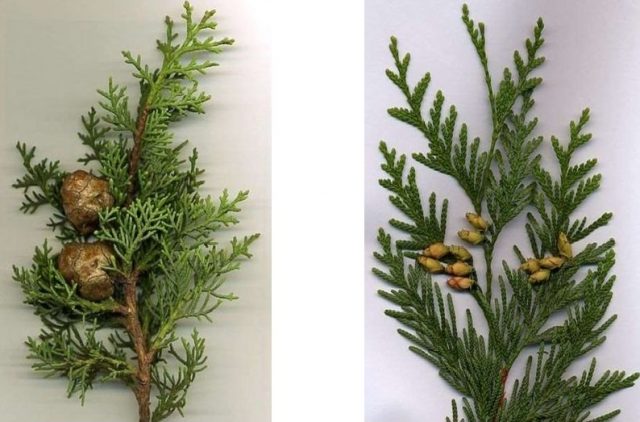Content
If we consider trees from a decorative point of view, it is impossible to ignore such species as thuja and cypress. These trees are usually used as decorative hedges; they are used to decorate the facades of buildings and structures. It is important to understand that there are species that have the maximum similarity, as a result of which it is sometimes quite difficult to understand exactly how thuja differs from cypress.
What is the difference between cypress and thuja
To understand the differences between cypress and thuja, it is recommended to compare biological characteristics. As a rule, this applies to cones:
- Thuja cones are oblong, they have several pairs of scales that are arranged crosswise;
- Cypress cones are spherical in shape, and they have multifaceted shields of scales.
It is also worth taking into account the location of the needles, since they are located in different planes in cypress with a pronounced ethereal smell, and in one plane in thuja, with a rather bright sweetish smell.
In addition, it is important to understand that these cultures differ in their medicinal properties. For example, thuja has an antibacterial effect, helps optimize blood circulation, relieves inflammation and spasms.Oil of the second type of tree helps fight stress; it is actively used to treat bronchitis.
Differences between cypress and thuja by place of growth
These plants are fairly close relatives, with the exception of preference for climatic conditions. Thuja prefers to grow in cool areas, which is why it is grown mainly in the middle zone. Cypress prefers subtropics.
If we consider the natural habitat of thuja, it is worth noting that the species is mainly located in the southeastern part of Canada and in the northern part of the United States. In addition, trees can be found on the western side of Anticosti Island. Thuja can also be found in New York, Tennessee, and Minnesota.
The natural habitat of cypress is the territory of Sakhalin, Crimea, China, America, the Caucasus, as well as the Black Sea coast.
How to distinguish thuja from cypress visually
Thuja is an evergreen coniferous plant belonging to the Cypress family. All thuja shoots are covered with needles in the form of small needles. In the spring, the shoots become a rich green hue, closer to autumn the color becomes much darker, and during the cold season it is brown. The visual difference in this case lies in the flowering. Thus, male thuja spikelets are located in the lower part of the tree and have a brownish-yellow tint. Female spikelets are much lighter and are located in the upper part. Thuja blooms until the young shoots grow, after which oval-shaped cones appear.
Cypress is a prominent representative of ornamental coniferous trees. This type is actively used in landscape design.It is important to understand that cypress and thuja look very similar in shade, needles and shoots. The difference is that the cones are not oval, but round.
Which is better - cypress or thuja
It is impossible to give a definite answer and say what exactly will be better. Each type is good in its own way and has an attractive appearance. In this case, everyone must choose what they like, taking into account the differences.
Thuja. An excellent option for decorating areas that lack lighting. Most often used as a hedge. The difference is that this variety can grow on swampy and peaty soils, on which, as a rule, most cultivated plants cannot grow. Under natural conditions, the height of the thuja can reach up to 25 m. The crown has a narrow pyramidal shape, which becomes oval over time.
Cypress is one of the most popular decorative species used for hedges. As a rule, they are planted in gardens and parks. Due to the presence of small varieties, it can be used as a decorative houseplant if necessary.
Features of caring for thuja and cypress
If we consider the differences in care between thuja and cypress, then all procedures will be basically the same. Since in both cases proper and high-quality care is required.
After the planting material has been planted in open ground, the following work will need to be carried out:
- water the crop - watering should be frequent and moderate, the soil should not be swampy and very dry;
- loosening is carried out after each irrigation of the soil;
- Removing weeds is an important point that needs to be given due attention. This is due to the fact that weeds they take all nutrients from the soil, as a result of which the planting material develops very poorly;
- fertilizing - in this case, you can use combined mineral fertilizers and organic matter, which will allow the plantings to grow much faster;
- Before the onset of the first cold weather, it is necessary to take care of the shelter, which will prevent the young shoots from freezing.
Conclusion
Thuja differs from cypress not only in its place of growth, but also in appearance. The difference lies mainly in the shape of the cones. If you understand what exactly to pay attention to, you can quite easily distinguish the two types visually.










